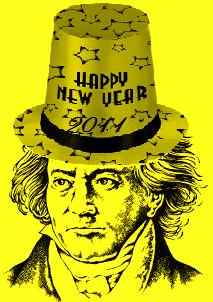In many parts of the world it's common to find a performance of Beethoven's 9th Symphony. It's a great work of music with a very powerful sonic design - and it has a message of universal brotherhood which is Beethoven's most sincere message to posterity: "Be embraced, This kiss for the whole world!".
The lyrics were originally written by the German poet Friedrich Schiller in 1785, but Beethoven made a few slight changes in his adaptation. The English translation of the 4th Movement text is as follows (Beethoven's additions in red):
Oh friends, not these tones!
Rather, let us raise our voices in more pleasing
And more joyful sounds!
Joy! (Joy!)
Joy! (Joy!)
Joy, beautiful spark of divinity*
Daughter of Elysium,
We enter, drunk with fire,
Into your sanctuary, heavenly (daughter)!
Your magic reunites
What custom strictly divided.
All men become brothers,
Where your gentle wing rests.
Whoever has had the great fortune
To be a friend's friend,
Whoever has won a devoted wife,
Join in our jubilation!
Indeed, whoever can call even one soul,
His own on this earth!
And whoever was never able to, must creep
Tearfully away from this band!
Joy all creatures drink
At the breasts of nature;
All good, all bad
Follow her trail of roses.
Kisses she gave us, and wine,
A friend, proved in death;
Pleasure was given to the worm,
And the cherub stands before God.
Before God!
Glad, as His suns fly
Through the Heaven's glorious design,
Run, brothers, your path,
Joyful, as a hero to victory.
Be embraced, millions!
This kiss for the whole world!
Brothers, above the starry canopy
Must a loving Father dwell.
Do you bow down, millions?
Do you sense the Creator, world?
Seek Him beyond the starry canopy!
Beyond the stars must He dwell.
Finale repeats the words:
Be embraced, you millions!
This kiss for the whole world!
Brothers, beyond the star-canopy
Must a loving Father dwell.
Be embraced,
This kiss for the whole world!
Joy, beautiful spark of divinity,
Daughter of Elysium,
Joy, beautiful spark of divinity
Divinity!
The full German text (in case you want to sing along) can be found HERE.
Leonard Bernstein puts it better than I ever could:
Playlist
Peace on Earth, Good will To Men.











































